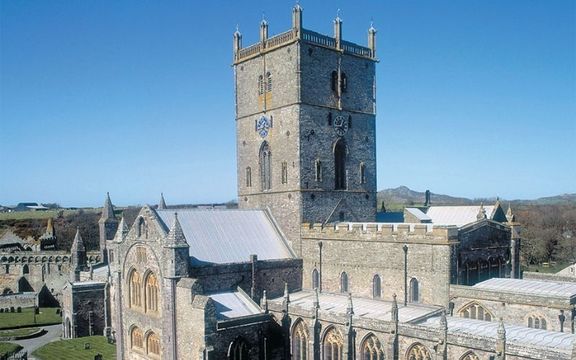
So, who were those holy Welshmen?
One of the delights of travelling around Wales is encountering fascinating place names. They may resist a smooth roll around the tongue at first, but with just a modicum of linguistics, you can discover whole stories within them, like peeling open the wrappers of history’s goodies.

The 12th-century Cathedral Church of Bangor is dedicated to St. Deniol, and built on the site of the saint’s 6th-century monastery
Llan–this–and–that is everywhere, the most common place-name type, and springs from Welsh for a religious enclosure or church building, maybe taking you back to the origins of the settlement. Add a saint—say, Dewi (David), Illtud or Padarn—and you have Llandewi, Llanilltud, Llanbadarn.
One writer has counted above 800 saints of Welsh origin known to this day, and about 600 associated feast days. That’s somewhat short of the 20,000 saints allegedly buried on Bardsey Island, centuries-old haven for pilgrims off the Lleyn peninsula. But it’s plenty to occupy the imagination. Who were all these holy people?
The key lies in the dramatic Age of Saints. There’s a popular view that Christianity, introduced to Britain during the Roman era, hurriedly left again with the legions early in the 5th century; that the Dark Ages cast a heathen shroud over all until St. Columba brought the Gospel from Ireland to the Scottish island of Iona in 563, and St. Augustine popped over to Canterbury from Rome in 597 to reconvert the pagans of southern England. Do you hear folks of Celtic stock spluttering?
Read more
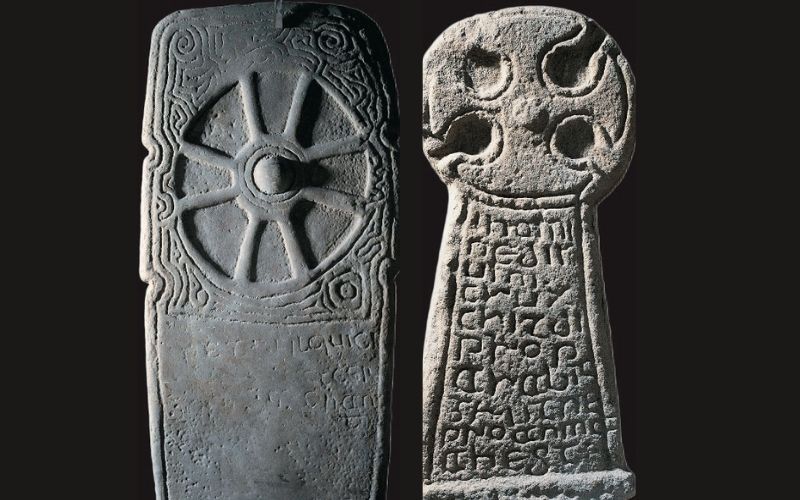
Dating from the 6th century, the Margam Stones record big events and mark Christian burials
This, then, was the Age of Saints. And by “saint” we don’t mean the canonized variety—that wasn’t their way—but the prominent holy men and women who lived by and spread The Word in post-Roman Britain. They also brought a sea change.
Christianity had been largely confined to urban centers in the Roman era, but these Celtic saints, much inspired by anchorite ideas from the Middle East, preferred the ways of wandering missionaries. They preached and converted in the countryside, among what we might call the ordinary folk. They adopted eremitic lifestyles or founded small monastic communities.
So much for the historical broad brush. Let’s roll out the map to find some of the key players in Wales. St. Dyfrig, or Dubricious, was a major figure crucial to the early continuation of Christianity, appearing in accounts as a bishop, confessor and founder of teaching monasteries.
He ordained St. Samson as deacon and then priest when he visited Llantwit Major, for example. Follow in his steps to the historic little south Wales town in the Vale of Glamorgan and you’ll be at the site of the school and monastery established by St. Illtud circa AD 500, claimed as Britain’s oldest center of learning. Students besides Samson included Gildas, known as Wales’ first historian.
The Life of Samson, compiled by a monk probably in the 7th century, says that Illtud was “of all the Britons the most accomplished in the Scriptures, namely the Old and New Testaments, and in the philosophy of every kind, of form, geometry namely, and of rhetoric, grammar and arithmetic, and of all the theories of philosophy. And by birth he was the wisest magician, having knowledge of the future.” Which seems a neat catch-all fusion of disciplines rooted in Roman, monastic and native Welsh heritage.
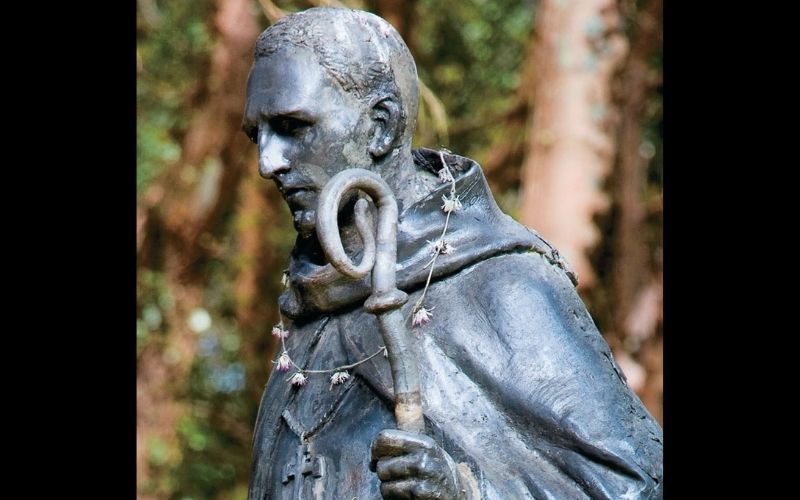
Seventh-century St. Samson was renowned for his knowledge and wisdom
The Welsh for Llantwit Major is Llanilltud Fawr, “the great church of St. Illtud,” but sadly the original has vanished. The Norman-dated church of today is nevertheless an inspiring visit, not least for the wonderful 8th-11th-century inscribed stones and crosses it contains. Parishioners at Llantwit are currently busy fundraising to create what should be a fascinating center for Celtic Christian Studies.
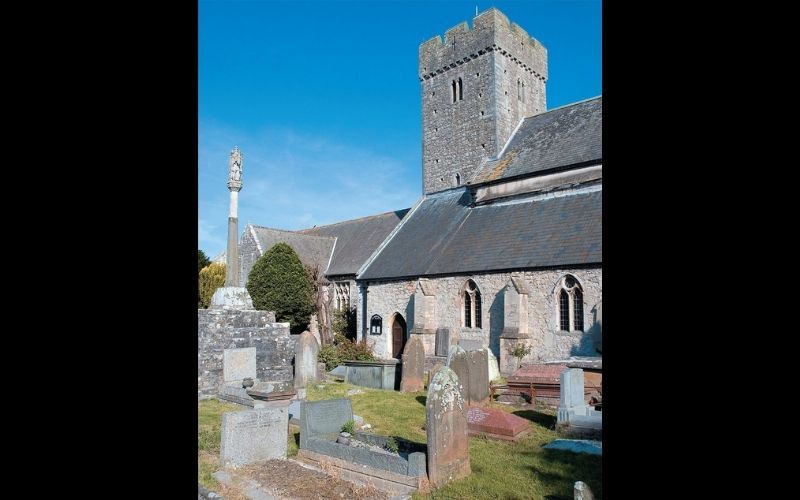
Hundreds of Welsh churches are dedicated to saints whose lives are largely lost in the mists of history—such as St. Illtuds Church in Llantwit Major
Sculptured crosses, marking burials or recording historic events, are really the only physical monuments to survive from the Welsh monasteries or collegiate churches, of the Age of Saints. And they bear testament to the privilege, much sought after by royalty and the like, of burial in their cemeteries. Margam Stones Museum, near Port Talbot, is another place to admire the handiwork of early sculptors.
The Bishop of St. Davids chats about ancient saints
More than 50 churches, all in South Wales, are dedicated to David, but no site is more numinous than the miniature Pembrokeshire city bearing his name. According to the 11th-century writings of Rhygyfarch, “Dewi Sant” was born on a stormy clifftop here to Non, a beautiful nun raped by Sant, king of Ceredigion. A little well and chapel named after her mark the spot, offering a humble counterpoint to the purple-stone medieval cathedral that stands on the site of David’s 6th-century monastery.
The saint’s exact birth date is unknown, but his death is usually said to be March 1, 589 or 601, at the alleged age of 147. Early in his life he was ordained to the priesthood and encouraged towards monasticism; he travelled on missionary work and founded 12 monasteries, including Glastonbury and Bath, so Rhygyfarch says.
At Vallis Rosina (St. Davids), he founded his chief monastery, and here he and his followers led an ascetic life, worshipping and working the land. They dined plainly off bread, vegetables, milk and water; David eschewed the milk.
Before Dewi’s birth, it was foretold that he would be enriched with mystical gifts; an angel even warned Ireland’s St. Patrick against settling at Vallis Rosina, to leave the way clear for Dewi’s work. David’s miracles ranged from curing the blind to creating wells and raising people from the dead. When he travelled with Teilo and Padarn on pilgrimage to Jerusalem, the patriarch elevated him to the dignity of archbishop.
Most famously, at the Synod of Llanddewi Brefi (Ceredigion), the ground rose beneath David so that the crowds could see and hear him preach.
How closely do we believe Rhygyfarch’s Life of St. David or any of the 11th/12th-century lives of saints? The Bishop of St. David’s, the Right Rev. John Wyn Evans, is a leading expert on early Welsh saints and co-editor of St. David of Wales: Cult, Church and Nation (Boydell Press).
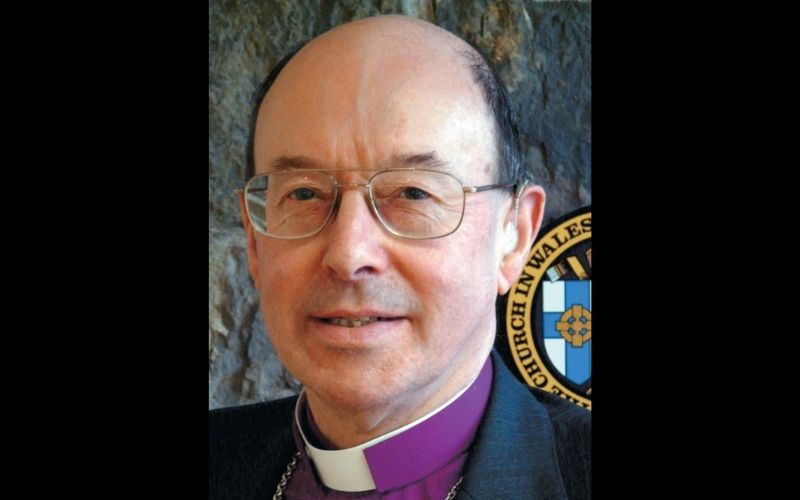
The Bishop of St. Davids, the Right Rev. John Wyn Evans, is an expert on early Welsh saints
“Only the top saints had Lives written about them, but you have to remember they are not history,” Bishop Evans says. “They are making points about the status and importance of the churches which actually wrote them.
“The expansion of a saint’s cult, which took centuries, had to do with all sorts of factors, like how successful they were in attracting lands. Cults don’t depend on the person themselves; they depend on patronage, usually from kings and princes—although the cult could not have happened unless there was a substantial real person. The reason that the cult of David became preeminent is because of the patronage of the House of Deheubarth. Four members of the dynasty are buried in St. Davids Cathedral.”
David had already emerged as a leading Welsh saint by the 10th century—witness the poem Armes Prydein Vawr (“The Great Prophecy of Britain”) predicting Welsh victory under the patronage of David against the English. Rhygyfarch’s “PR” gave added impetus.
In 1123 St. Davids’ Norman Bishop Bernard gained a valuable privilege from Pope Callixtus II, who declared that two pilgrimages to St. Davids were equivalent to one to Rome. Even England’s Henry II and Edward I thought it wise to visit the shrine of the patron of the people they wished to subdue, as William the Conqueror did before them.
The fate of David’s corporeal relics is not known. The cathedral was raided by Vikings and also despoiled at the Reformation; remains “rediscovered” in the Victorian era proved to be mid-12th to 14th century. It was Bishop Evans who as dean in 1996 agreed to carbon dating. Was he concerned by the outcome? “Good heavens, no. I’m an archaeologist by training,” he explained.
And I ask: had cults, patronage and campaigns panned out differently, could some other saint than David have been patron of Wales? The bishop laughs. “That is an interesting point. I suppose it’s true, but it didn’t happen, did it?”
Southeast Wales was a hotbed of saintly activity, and likely you’ll come across churches dedicated to the 6th-century martyr Cadoc, killed by the English. There’s one in the Vale of Glamorgan at Llancarfan featuring puzzling woodcarvings among its treasures. Once the site of Cadoc’s monastery and a famous center of learning, Llancarfan is now an attractive village—enjoy refreshments in the Fox & Hounds, saved from closure by a community “buyout.”
Then hop up the coast to Caldey Island, reached by a 20-minute boat trip from Tenby, Pembrokeshire. Monks from Llantwit Major founded the first Celtic monastery here and lived in wattle and mud cells, while the more solitary minded sought out caves along the sea cliffs. Illtud and Dyfrig visited, and Samson became the island’s second abbot in 550. Caldey’s first abbot, Pyro, had met an unseemly death when he drunkenly fell down a well. Today Caldey is owned by Reformed Cistercians.
After lunch in the village, overlooked by the Italianate abbey, seek out St. Illtud’s Church for the cryptically inscribed Ogham Stone, said to date from the time of Samson.
Among a generation of saints thought to be later than Dyfrig, Illtud et al., there’s David to take us to St. David’s, also in Pembrokeshire: as patron saint of Wales he gets his own sidebar in this feature. The abbot/bishop/confessors Teilo and Padarn were the most famous of southwest Wales’ saints, alongside David, and travelled with him on pilgrimage to Jerusalem. No prizes for spotting the connection between Teilo and the town of Llandeilo in Carmarthenshire, where he was bishop in the 6th century.
And the village of Llandbadarn Fawr near Aberystwyth owes its existence to the church founded by St. Padarn, probably on the site of the present churchyard. The impressively towered medieval church houses ancient stone crosses, Padarn’s Room depicting scenes from the saint’s life and Sulien’s Room, recalling a later leader of the church who was also twice bishop of St. David’s. Sulien’s son Rhygyfarch composed the influential Life of St. David in Llanbadarn’s scriptorium in the 11th century.
In north Wales, St. Deiniol, a missionary of noble birth, built a church within a bangor (fence) in the 6th century—and so the town of that name grew and the later Cathedral Church of St. Deiniol was raised.
However, the 7th-century missionary St. Beuno boasts the most church dedications in the north. He is popularly remembered for restoring life to his niece, Gwenfrewi or Winefride, who spurned Prince Caradog’s advances and consequently had her head cut off. It rolled down a hill, and where it rested a spring appeared. To this day you can bathe in the reputed healing waters at Holywell. Beuno, having put Winefride’s head back on her shoulders, cursed Caradog, causing the earth to swallow him up.
Many more saints could be conjured, but we’ve had a reasonable taste. Panning back out to the wider picture, Celtic and Roman Christianity had been growing in England via the missions of Columba and Augustine. Differences in practice between the two forms of faith brought tensions but were largely settled at the Synod of Whitby in 664. Many people in Wales, accustomed to going their own religious way, nevertheless resisted Papal authority.
Taking a saintly pilgrimage
The Church in Wales
www.churchinwales.org.uk
Llandaff Cathedral
www.llandaffcathedral.org.uk
Pembrokeshire/southwest Wales:
Caldey Island
www.caldey-island.co.uk
St. Padarn Church, Llanbadarn
Fawr, Aberystwyth
www.stpadarns-llanbadarn.org.uk
The Saints and Stones trails
www.saintsandstones.co.uk
Five pilgrimage routes across Pembrokeshire, taking in churches and ancient sites associated with Wales’ saints and holy men.
North Wales:
Bardsey Island
www.bardsey.org
St. Winefride’s Well, Holywell
www.saintwinefrideswell.com
* Originally published in 2016





Comments